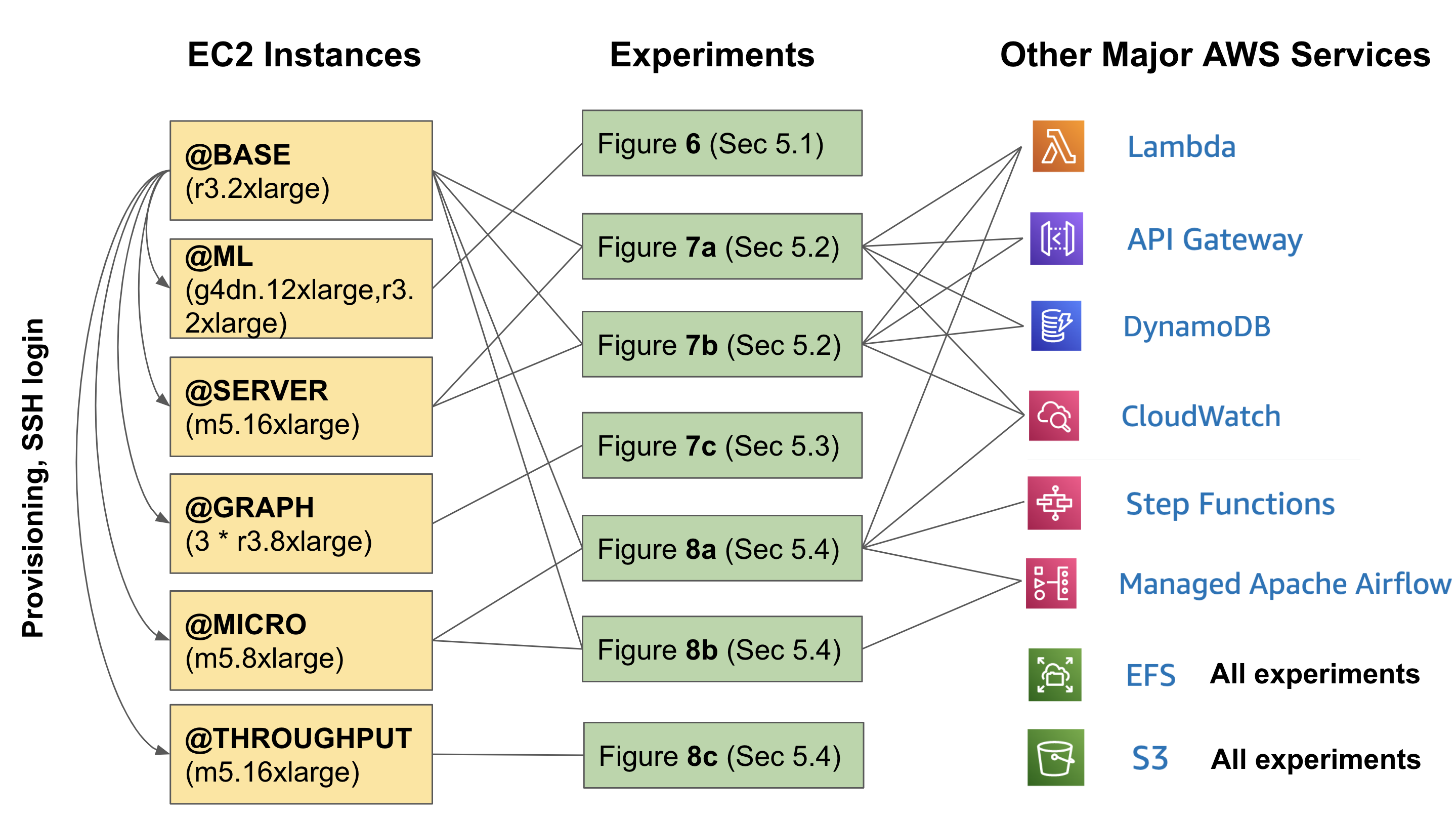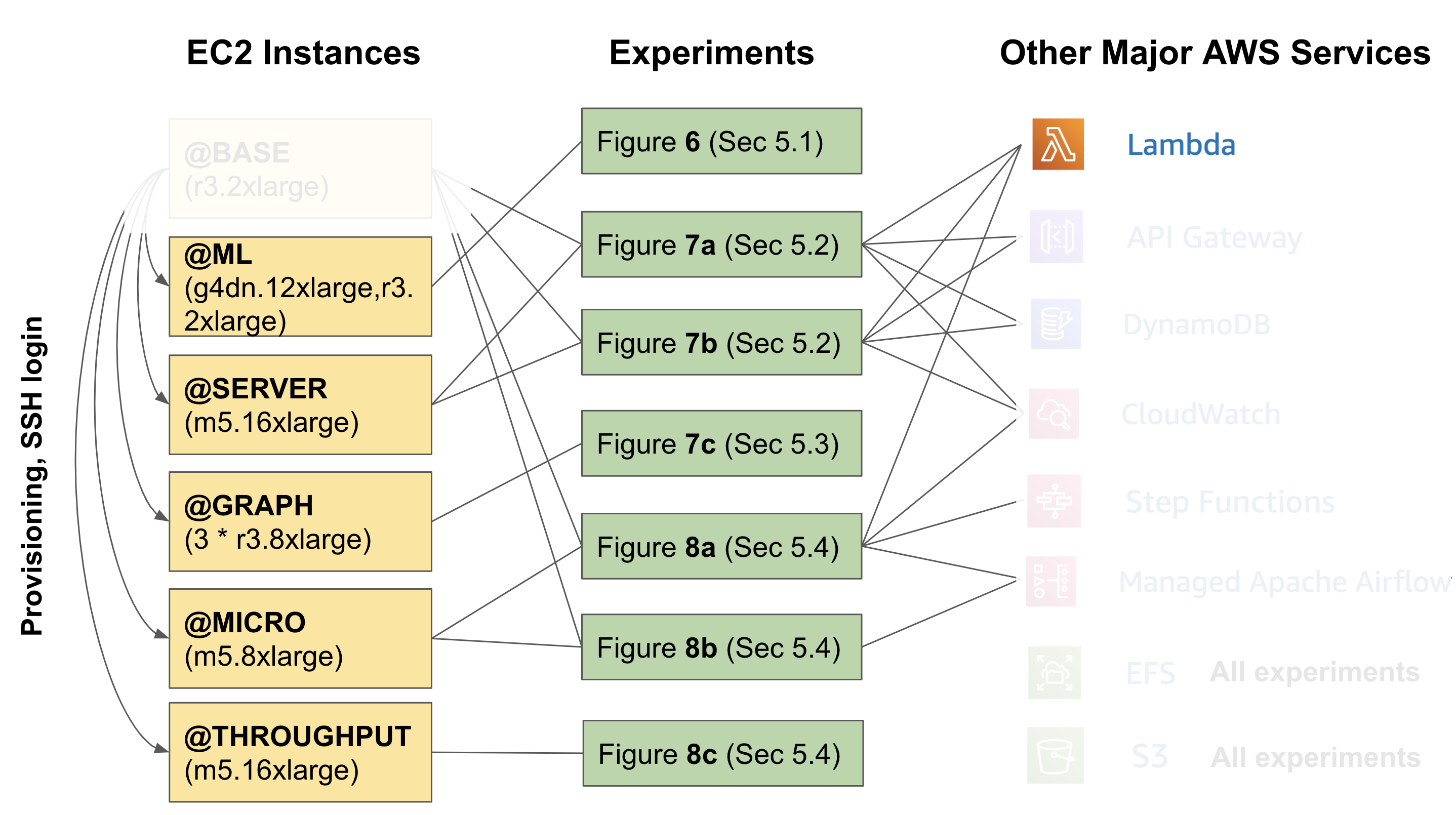Checkout the artifact branch for the original code/script for artifact evaluation.
OSDI'23 Artifact Evaluation
This guide is designed to assist you in setting up and running experiments for the ExoFlow paper. It is organized into three primary sections: Local Setup, Main Results, and Microbenchmarks.
Please follow the instructions in each section to reproduce the results.
NOTE: All experiments in the paper were executed in batch mode with proper warm-up. To facilitate the reviewer's reproduction of the results, we provide commands to run each experiment individually. If you encounter significant overhead due to insufficient warm-up during these individual runs, we recommend running the experiment again after the initial run for better results.
Our artifact operates on Amazon AWS. Below is a summary of the key AWS resources utilized in the artifact for each experiment, which you can refer to when you are running the experiments:
We understand that the graph above may seem intimidating, particularly for evaluators who are not very familiar with AWS. This is primarily due to the fact that our paper encompasses a wide variety of experiments, and we must use different baselines and setups for each experiment since the baselines might not be as versatile as ExoFlow. Additionally, we aim to include more systems for comparison.
However, there is no need to worry because (1) we have prepared most of the resources for you, and we will provide instructions for logging into our instance to run all experiments with significantly fewer steps, and (2) if you truly wish to build and test everything from the ground up on your own AWS cloud, we also offer a document that guides you through the setup process step by step.
Obtain the SSH key and configuration for the artifact by utilizing the password supplied in the OSDI'23 artifact submission form. The SSH key is required for accessing @BASE. Decrypt the SSH key and configuration by extracting the contents of the osdi23ae_access.zip file, located in the artifact's root directory. It is essential to set the permission for the SSH private key file (osdi23ae) to 600; otherwise, the SSH connection may fail.
Here are all the components you need to setup manually (we have already setup the rest for you):
The majority resources the evaluators need to setup manually with our account (i.e. provision on @BASE) are EC2 instances. We did not prepare them for evaluators because it is too expansive to keep them running during artifiact evaluation. Instead, evaluators can set them up with simple one-liners.
IMPORTANT NOTES
- We trust our evaluators and grant them extensive permissions to streamline the evaluation process. However, please refrain from using or modifying our cloud resources in ways unrelated to artifact evaluation.
- Our experiments are not designed for multi-tenancy. We kindly request that evaluators coordinate with each other and avoid running multiple experiments simultaneously. This could cause disruptions to the environment or impact the timing of the experiments.
- After completing the evaluation, please terminate all EC2 instances other than
@BASEusing the commandray down <the corresponding YAML file>. - By default, execute all subsequent experiment commands within
@BASE.
This section is divided into three subsections, representing the main results of the paper: 5.1 ML training pipelines, 5.2 Stateful serverless workflows and 5.3 Online-offline graph processing.
To run the experiment, start the cluster from @BASE by running:
ray up -y /exoflow/clusters/distributed_training_cluster.yamlLet us call the cluster @ML.
Wait until @ML is fully ready.
NOTE: We use Ray to start clusters. Ray first starts the head node. After the head node is ready, you will see instructions about how to log into the head node. However, if your cluster has more than one node, then besides the "head node", you will also have some "worker nodes". Ray starts the worker nodes only after the head node is ready. Worker nodes are necessary for the experiments, so you have to wait some extra time for the worker node to be fully setup. It will take similar or longer time to setup the worker node compared to the head node. For this experiment, it usually takes another 5 minutes.
The experiments below are running on @ML! Please SSH into @ML first. You can either follow the instructions printed by "ray up ..." command, or execute this:
cd /exoflow/clusters
ray attach distributed_training_cluster.yaml(~12 hours) Batch run all experiments with the following command on @ML:
cd /exoflow/experiments/distributed_training
./run.shAlternatively, you can run the experiments individually (10-12 min each):
Selective AsyncCkpt
cd /exoflow/experiments/distributed_training
./restart_ray.sh
python run.py --checkpoint=hybrid --enhance-dataset-multiplier=<dataset size>NoCkpt
cd /exoflow/experiments/distributed_training
./restart_ray.sh
python run.py --checkpoint=false --enhance-dataset-multiplier=<dataset size>AsyncCkpt
cd /exoflow/experiments/distributed_training
./restart_ray.sh
python run.py --checkpoint=async --enhance-dataset-multiplier=<dataset size>SyncCkpt
cd /exoflow/experiments/distributed_training
./restart_ray.sh
python run.py --checkpoint=true --enhance-dataset-multiplier=<dataset size>Workflow Tasks
cd /exoflow/experiments/distributed_training
./restart_ray.sh
python run.py --checkpoint=false --enhance-dataset-multiplier=<dataset size> --disable-ephemeral-tasks(~20 hours) Batch run all experiments with the following command on @ML:
cd /exoflow/experiments/distributed_training
./run_fault_tolerance.shAlternatively, you can run the experiments individually (~30 min each):
Cluster Failure
cd /exoflow/experiments/distributed_training
cluster_failure="train_12.cluster_crash"
# Selective AsyncCkpt
workflow_id=$(openssl rand -hex 12)
./restart_ray.sh && python run.py --checkpoint=hybrid --enhance-dataset-multiplier=4 --failure=$cluster_failure --workflow-id=$workflow_id
./restart_ray.sh && python run.py --checkpoint=hybrid --enhance-dataset-multiplier=4 --failure=$cluster_failure --workflow-id=$workflow_id --resume
# NoCkpt
workflow_id=$(openssl rand -hex 12)
./restart_ray.sh && python run.py --checkpoint=false --enhance-dataset-multiplier=4 --failure=$cluster_failure --workflow-id=$workflow_id
./restart_ray.sh && python run.py --checkpoint=false --enhance-dataset-multiplier=4 --failure=$cluster_failure --workflow-id=$workflow_id --resume
# SyncCkpt
workflow_id=$(openssl rand -hex 12)
./restart_ray.sh && python run.py --checkpoint=true --enhance-dataset-multiplier=4 --failure=$cluster_failure --workflow-id=$workflow_id
./restart_ray.sh && python run.py --checkpoint=true --enhance-dataset-multiplier=4 --failure=$cluster_failure --workflow-id=$workflow_id --resumeOther Failure
Other failure is based on this template:
cd /exoflow/experiments/distributed_training
rm *.task_crash
rm *.cluster_crash
# Selective AsyncCkpt
./restart_ray.sh && python run.py --checkpoint=hybrid --enhance-dataset-multiplier=4 --failure=<failure_trigger>
# NoCkpt
./restart_ray.sh && python run.py --checkpoint=false --enhance-dataset-multiplier=4 --failure=<failure_trigger>
# SyncCkpt
./restart_ray.sh && python run.py --checkpoint=true --enhance-dataset-multiplier=4 --failure=<failure_trigger>Here are the corresponding failure triggers:
- Ingestion Data Worker Failure:
preprocess.task_crash - Training Actor Failure:
train_actor_8.task_crash - Augmentation Task Failure:
transform_8.task_crash - Augmentation Data Worker Failure:
transform_subtask_8.task_crash
The results for figure 6 are stored in /exoflow/experiments/distributed_training/results. They are quiet self-explanatory, where each row represents the running time of one experiment with corresponding configuration. To plot the results, run:
cd /exoflow/experiments/distributed_training
python plot.pyThe plots are stored in /exoflow/experiments/distributed_training/plots.
Before running the experiments, set up the serverless functions and the ExoFlow server.
Deploy the serverless functions (@BASE):
# deploy shared Lambda functions for ExoFlow
/exoflow/experiments/stateful_serverless/deploy-exoflow.shSet up the ExoFlow server to run stateful serverless workflows with ExoFlow.
In the shared cluster, run the following command to set up the ExoFlow server:
ray up -y /exoflow/clusters/stateful_serverless_exoflow_cluster.yaml --disable-usage-statsWe will call the cluster @SERVER.
After @SERVER is ready, follow the instructions on your screen to log in to @SERVER. Then, run the following command on @SERVER to start the ExoFlow server:
cd /exoflow/experiments/stateful_serverless
pip install -r requirements.txt
./start_exoflow_server.shThe server is ready when you see a few messages like this (it will take ~2min):
[2023-04-24 06:05:25 +0000] [4913] [INFO] Application startup complete.
It is normal for the server to print messages like:
(WorkflowManagementActor pid=51786) 2023-04-24 07:15:58,611 WARNING worker.py:2254 -- Using blocking ray.get inside async actor. This blocks the event loop. Please use `await` on object ref with asyncio.gather if you want to yield execution to the event loop instead.
Beldi
(~75 min) Batch run all experiments with the following command on @BASE:
docker exec -w /root/beldi -it beldi bash -ic "/stateful_serverless/benchmark/batch-beldi.sh"(recommanded) Alternatively, you can run the experiments one by one with the rate (i.e., throughput) you want (7-10 min):
docker exec -w /root/beldi -it beldi bash -ic "/stateful_serverless/benchmark/benchmark-beldi.sh $rate"Check Beldi results in /exoflow/experiments/stateful_serverless/result/beldi/
ExoFlow
(~75 min) Batch run all experiments with the following command on @BASE:
docker exec -w /root/beldi -it beldi bash -ic "/stateful_serverless/benchmark/batch-exoflow.sh"(recommanded) Alternatively, you can run the experiments one by one with the rate (i.e., throughput) you want (7-10 min):
docker exec -w /root/beldi -it beldi bash -ic "/stateful_serverless/benchmark/benchmark-exoflow.sh $rate"Check ExoFlow results by running python /exoflow/experiments/stateful_serverless/collect_metrics.py and check the workflow-server field in /exoflow/experiments/stateful_serverless/result/result.json. The array in the field represents the latency under the throughput of [100, 200, 300, 400, 500, 600, 700, 800, 900, 1000] requests per second.
ExoFlow-Failure
This experiment requires an extra deployment on @BASE:
/exoflow/experiments/stateful_serverless/deploy-exoflow-ft.shNOTE: This deployment overwrites the previous ExoFlow deployment. If you want to run the previous experiments, you need to redeploy the serverless functions (deploy-exoflow.sh).
(~75 min) Batch running of all experiments with the following command on @BASE:
docker exec -w /root/beldi -it beldi bash -ic "/stateful_serverless/benchmark/batch-exoflow-failure.sh"(recommanded) Alternatively, you can run the experiments one by one with the rate (i.e., throughput) you want (7-10 min, on @BASE):
docker exec -w /root/beldi -it beldi bash -ic "/stateful_serverless/benchmark/benchmark-exoflow-failure.sh $rate"Check ExoFlow-Failure results by running python /exoflow/experiments/stateful_serverless/collect_metrics.py and check the workflow-server-failure field in /exoflow/experiments/stateful_serverless/result/result.json. The array in the field represents the latency under the throughput of [100, 200, 300, 400, 500, 600, 700, 800, 900, 1000] requests per second.
Beldi
(7-10 min) Beldi:
docker exec -w /root/beldi -it beldi bash -ic "/stateful_serverless/benchmark/benchmark-beldi-reserve.sh"(~60 min) Batch run all experiments with the following command on @BASE:
docker exec -w /root/beldi -it beldi bash -ic "/stateful_serverless/benchmark/batch-exoflow-reserve.sh"Or your can run them one by one:
(7-10 min) "-WAL"
docker exec -w /root/beldi -it beldi bash -ic "/stateful_serverless/benchmark/benchmark-exoflow-reserve.sh reserve_serial"(7-10 min) "+parallel"
docker exec -w /root/beldi -it beldi bash -ic "/stateful_serverless/benchmark/benchmark-exoflow-reserve.sh reserve"(7-10 min) "+async"
docker exec -w /root/beldi -it beldi bash -ic "/stateful_serverless/benchmark/benchmark-exoflow-reserve.sh reserve_overlapckpt"(7-10 min) "-async"
docker exec -w /root/beldi -it beldi bash -ic "/stateful_serverless/benchmark/benchmark-exoflow-reserve.sh reserve_nooverlapckpt"Check results by running python /exoflow/experiments/stateful_serverless/collect_metrics.py and look into /exoflow/experiments/stateful_serverless/result/result.json. Here is the mapping between the field in the result JSON file and the legend in the figure:
- beldi-cloudwatch-reserve -> Beldi
- reserve_serial -> +WAL
- reserve -> +parallel
- reserve_overlapckpt -> +async
- reserve_nooverlapckpt -> -async
You could further run python /exoflow/experiments/stateful_serverless/plot.py to plot Figure 7(a) and 7(b). The generated figures are saved in /exoflow/experiments/stateful_serverless/plots.
Start a cluster for graph processing:
ray up /exoflow/clusters/graph_streaming_cluster.yaml -y --disable-usage-statsLet's call the cluster @GRAPH.
Then SSH into @GRAPH following the instructions from the output of the command, after the cluster is up. Then wait for about 5min for the whole cluster to be ready.
On @GRAPH, first, config the Spark cluster:
/exoflow/experiments/graph_streaming/config_spark_cluster.shThen run the experiments on @GRAPH in batch (~6 hours):
cd /exoflow/experiments/graph_streaming
./run.shYou can easily split the batch into 3 parts (1.5-2.5 hours each):
# ExoFlow NoCkpt
python run.py --checkpoint=false
# ExoFlow AsyncCkpt
python run.py --checkpoint=async
# ExoFlow SyncCkpt
python run.py --checkpoint=trueNOTE: It takes a long time for each experiment to start, due to writing the DAG to S3.
After the experiments are done, you can collect the results by running:
cd /exoflow/experiments/graph_streaming
python collect_metrics.pyExisting results are saved in result/analyze_outputs. They are array of latency per iteration.
Finally, you can plot the results by running:
cd /exoflow/experiments/graph_streaming
python plot.pyThe generated figures are saved in plots.
(~10min to setup)
For the microbenchmarks, you need to setup a cluster (besides @BASE) for running the microbenchmarks.
ray up /exoflow/clusters/microbenchmarks_cluster.yaml -y --disable-usage-statsLet's refer to this cluster as @MICRO. You can log into @MICRO (from @BASE) by running:
ray attach /exoflow/clusters/microbenchmarks_cluster.yamlSetup
Log into @MICRO from @BASE. Then run the following commands:
cd /exoflow/experiments/microbenchmarks/latency
./start_server.shWait util the server is ready with this message:
INFO: Application startup complete.
INFO: Uvicorn running on http://0.0.0.0:8080 (Press CTRL+C to quit)
Benchmark
Run the following commands on @BASE (~6 min):
pip install shortuuid
cd /exoflow/experiments/microbenchmarks/latency/
./benchmark.shPlot the result:
cd /exoflow/experiments/microbenchmarks/latency/
python plot.pyThe output figure (microbenchmark-data-movement.png) is in the plots/ directory.
Setup
On @MICRO, run the following commands to config Spark:
/exoflow/experiments/microbenchmarks/data_sharing/config_spark.shThen run the following commands to start the Spark server that is called by Airflow:
python /exoflow/experiments/microbenchmarks/data_sharing/airflow_server.pyKeep this server running until the end of the experiment. For example, you can run it in a tmux session on @MICRO.
Benchmark
On @MICRO, run the following commands for benchmarking (~2 hour):
cd /exoflow/experiments/microbenchmarks/data_sharing
./benchmark.shPlot the result:
cd /exoflow/experiments/microbenchmarks/data_sharing
python plot.pyThe output figure (microbenchmark-data-shared.png) is in the plots/ directory.
On @BASE, launch the cluster:
ray up /exoflow/clusters/microbenchmarks-throughput-cluster.yaml -yLet's refer to this cluster as @THROUGHPUT.
On @THROUGHPUT, start the benchmark:
pip install shortuuid
cd /exoflow/experiments/microbenchmarks/throughput
./benchmark.shPlot the result:
cd /exoflow/experiments/microbenchmarks/throughput
python plot.pyThe output figure (microbenchmark-throughput.png) is in the plots/ directory.

